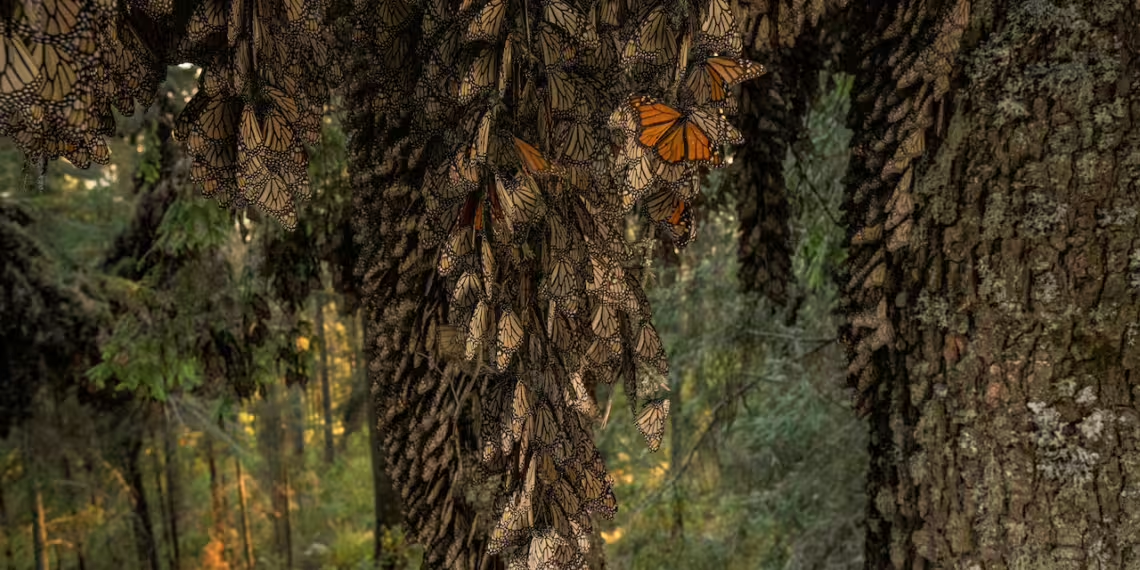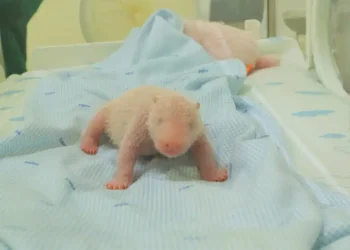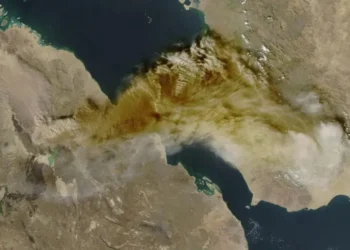Climate change could wipe out monarchs’ winter habitats by 2090, but an ‘assisted migration’ strategy aims to build new environs they could call home.
On the slopes of a volcano in central Mexico, biologist Cuauhtémoc Sáenz-Romero and his team envision a climate refuge for oyamel fir trees and the monarch butterflies that depend on them. In 2021, the researchers trekked up the mountain to plant seedlings in biting cold temperatures—part of an effort to save the species from a climate-driven demise.
About 80 miles away, in the Monarch Butterfly Biosphere Reserve, millions of monarch butterflies (Danaus plexippus) find haven in the oyamel fir (Abies religiosa) forests after an arduous migration from Canada and the United States down to Mexico for the winter. Now, as rising temperatures, droughts, and disease threaten the forests of the monarch reserve, scientists are hoping to help these trees migrate.
“We’re doing something different,” says Sáenz-Romero, a researcher at the Universidad Michoacana de San Nicolás de Hidalgo in Michoacán, also home to the reserve. “If we don’t do this, the trees in the monarch reserve are going to die.”
By 2090, the reserve’s forest habitats, located around 11,000 feet (3,500 meters), are expected to deteriorate, as temperatures warm. Using a technique called assisted migration, researchers might be able to move these trees to the nearby volcano, Nevado de Toluca, Sáenz-Romero and his colleagues recently reported in Frontiers in Forests and Global Change.
Future forests
Forests move naturally; they shift in many directions and elevations as climate changes. In Mexico, trees are slowly migrating up the mountains, but they’re doing so at a slower pace than that of climate change. In the monarch reserve, for instance, the highest oyamel fir populations are already at the summits, leaving them with nowhere to go.
Assisted migration helps the forest move more quickly than it would do so naturally. You collect seeds from a place with a specific climate, like the monarch reserve, and move them to an area that will have a similar climate in the future, explains Sáenz-Romero.
The experiment began in 2017, when Sáenz-Romero and his team gathered seeds from oyamel fir trees in the Monarch Butterfly Biosphere Reserve at various altitudes. For two years, the plants grew in a shade house and then for another year in a nursery at around 9,800 feet (3,000 meters) to help them adjust to the altitude. Then, in 2021, they worked with the local indigenous community of Calimaya to plant the seedlings under “nurse plants,” which protected them from harsh conditions, on the northeast slope of the Nevado de Toluca volcano. They focused on four different altitudes, ranging from roughly 11,000 to 13,000 feet (3,400 to 4,000 meters).
In 2023, six years after planting the seeds, they found that at two of those heights, 11,800 and 12,400 feet, nearly 70 percent of the seedlings had survived even at the higher elevation.
“These types of experiments are tremendously important,” says Sally Aitken, a professor in Forest and Conservation Sciences at the University of British Columbia, who wasn’t involved in the study. Aitken was also part of other field tests that involved moving whitebark pine, an endangered tree species in Canada, further north to protect it from warming temperatures and diseases like white pine blister rust.
However, assisted migration outside of a tree’s normal range comes with concerns, Aitken says. Oyamel firs don’t normally grow at this height on Nevado de Toluca’s slopes. Moving a species could have unintended ecological fallout for other species present in that ecosystem. There’s uncertainty around these field tests, she explains, but they’re crucial to better understand whether assisted migration could realistically save forest ecosystems.
This article was rewritten by JournosNews.com based on verified reporting from trusted sources. The content has been independently reviewed, fact-checked, and edited for accuracy, neutrality, tone, and global readability in accordance with Google News and AdSense standards.
All opinions, quotes, or statements from contributors, experts, or sourced organizations do not necessarily reflect the views of JournosNews.com. JournosNews.com maintains full editorial independence from any external funders, sponsors, or organizations.
Stay informed with JournosNews.com — your trusted source for verified global reporting and in-depth analysis. Follow us on Google News, BlueSky, and X for real-time updates.














